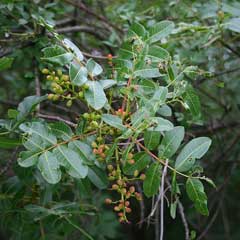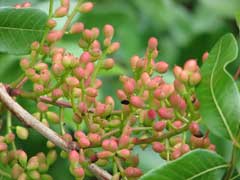 |
|
http://commons.wikimedia.org/wiki/User:Franz_Xaver |
 |
| greffer.net |
Translate this page:
Summary
Physical Characteristics

 Pistacia terebinthus is a deciduous Tree growing to 9 m (29ft) by 6 m (19ft) at a slow rate.
Pistacia terebinthus is a deciduous Tree growing to 9 m (29ft) by 6 m (19ft) at a slow rate.
See above for USDA hardiness. It is hardy to UK zone 9. It is in flower from May to July, and the seeds ripen from October to November. The species is dioecious (individual flowers are either male or female, but only one sex is to be found on any one plant so both male and female plants must be grown if seed is required). . The plant is not self-fertile.
Suitable for: light (sandy) and medium (loamy) soils and prefers well-drained soil. Suitable pH: mildly acid, neutral and basic (mildly alkaline) soils and can grow in very alkaline soils.
It cannot grow in the shade. It prefers dry or moist soil and can tolerate drought.
UK Hardiness Map
US Hardiness Map
Synonyms
Plant Habitats
Woodland Garden Sunny Edge;
Edible Uses
Edible Parts: Fruit Leaves Oil Seed
Edible Uses: Gum Oil
Seed - raw or cooked[177]. Sweetish[183]. It is sweeter and oilier than an almond[2]. An edible oil is obtained from the seed[117, 183]. The immature fruits, including the stems, are preserved in vinegar and salt. Known as 'atsjaar', they are used as a relish to accompany wines served during meals[183]. The fruit is about 7mm long and 6 mm wide, it contains a single seed[200]. Young leaves - cooked and used as a vegetable[177, 183]. A resin from the trunk is used as a vegetable and as a chewing gum[177, 183].
References More on Edible Uses
Medicinal Uses
Plants For A Future can not take any responsibility for any adverse effects from the use of plants. Always seek advice from a professional before using a plant medicinally.
Cytostatic Urinary
The resin obtained from this tree (see below for more details) is antiseptic, antispasmodic, cytostatic, expectorant and vulnerary[100, 238]. It is taken internally in the treatment of chronic bronchial infections, streptococcal, urinary and renal infections, haemorrhage, gallstones, tapeworm and rheumatism[238]. Externally, it is used to treat arthritis, gout, sciatica, scabies and lice[238]. It has also been used in the treatment of cancer[100].
References More on Medicinal Uses
The Bookshop: Edible Plant Books
Our Latest books on Perennial Plants For Food Forests and Permaculture Gardens in paperback or digital formats.

Edible Tropical Plants
Food Forest Plants for Hotter Conditions: 250+ Plants For Tropical Food Forests & Permaculture Gardens.
More

Edible Temperate Plants
Plants for Your Food Forest: 500 Plants for Temperate Food Forests & Permaculture Gardens.
More

More Books
PFAF have eight books available in paperback and digital formats. Browse the shop for more information.
Shop Now
Other Uses
Dye Gum Oil Resin Rootstock Tannin
Yields the resin 'Cyprus turpentine', which is obtained from incisions made in the bark (not the trunk) of the tree[1, 2, 11, 46, 117, 200]. The incisions are made from mid summer to mid autumn[238]. It is mainly used medicinally in the treatment of cancer[100] and also as a chewing gum. The plant can be used as a rootstock for the pistachio nut, P. vera[11]. A red dye is obtained from galls that are formed on the leaves by aphis[100]. The plant is a source of tannin[46].
Special Uses
Carbon Farming Scented Plants
References More on Other Uses
Cultivation details
Industrial Crop: Hydrocarbon Management: Standard Regional Crop
Requires a deep well-drained light soil[200], preferring a hot dry position in full sun[166]. It grows best in a sandy to stony alkaline soil[238]. This species is hardy in most of Britain but it is slow growing[1, 200]. This contradicts the report, also in [200], that this plant is only hardy to zone 9 and is therefore intolerant of anything other than the lightest frosts. Any pruning that needs to be done is best carried out in the spring[238]. Dioecious, male and female plants must be grown if seed is required.
Carbon Farming
-
Industrial Crop: Hydrocarbon
Materials, chemicals and energy include bioplastics, rubber, biomass products gasoline, jet fuel, diesel, butane, propane, biogas. Plants are usually resprouting plants and saps.
-
Management: Standard
Plants grow to their standard height. Harvest fruit, seeds, or other products. Non-Destructive management systems.
-
Regional Crop
These crops have been domesticated and cultivated regionally but have not been adopted elsewhere and are typically not traded globally, Examples in this broad category include perennial cottons and many nuts and staple fruits.
References Carbon Farming Information and Carbon Sequestration Information
Temperature Converter
Type a value in the Celsius field to convert the value to Fahrenheit:
Fahrenheit:
The PFAF Bookshop
Plants For A Future have a number of books available in paperback and digital form. Book titles include Edible Plants, Edible Perennials, Edible Trees,Edible Shrubs, Woodland Gardening, and Temperate Food Forest Plants. Our new book is Food Forest Plants For Hotter Conditions (Tropical and Sub-Tropical).
Shop Now
Plant Propagation
Pre-soak the seed for 16 hours in alkalized water[78], or for 3 - 4 days in warm water[1], and sow late winter in a cold frame or greenhouse[78, 113]. Two months cold stratification may speed up germination, so it might be better to sow the seed in early winter[113]. The germination is variable and can be slow. Prick out the seedlings into individual pots when they are large enough to handle and grow on the plants for at least their first winter in a greenhouse. Plant out into their permanent positions in early summer and consider giving some protection from winter cold for their first year or two outdoors[K]. Cuttings of half-ripe wood from juvenile trees, July in a frame[113]. Layering.
Other Names
If available other names are mentioned here
Native Range
TEMPERATE ASIA: Saudi Arabia, Cyprus, Israel, Jordan, Lebanon, Syria, Turkey EUROPE: Albania, Bulgaria, Bosnia and Herzegovina, Greece (incl. Crete), Croatia, Italy (incl. Sardinia, Sicily), Spain (incl. Baleares), France (s. & Corsica), Portugal AFRICA: Algeria (north), Libya (north), Morocco, Tunisia
Weed Potential
Right plant wrong place. We are currently updating this section.
Please note that a plant may be invasive in one area but may not in your area so it's worth checking.
Conservation Status
IUCN Red List of Threatened Plants Status :

Growth: S = slow M = medium F = fast. Soil: L = light (sandy) M = medium H = heavy (clay). pH: A = acid N = neutral B = basic (alkaline). Shade: F = full shade S = semi-shade N = no shade. Moisture: D = dry M = Moist We = wet Wa = water.
Now available:
Food Forest Plants for Mediterranean Conditions
350+ Perennial Plants For Mediterranean and Drier Food Forests and Permaculture Gardens.
[Paperback and eBook]
This is the third in Plants For A Future's series of plant guides for food forests tailored to
specific climate zones. Following volumes on temperate and tropical ecosystems, this book focuses
on species suited to Mediterranean conditions—regions with hot, dry summers and cool, wet winters,
often facing the added challenge of climate change.
Read More
Expert comment
Author
L.
Botanical References
1150200
Links / References
For a list of references used on this page please go here
Readers comment